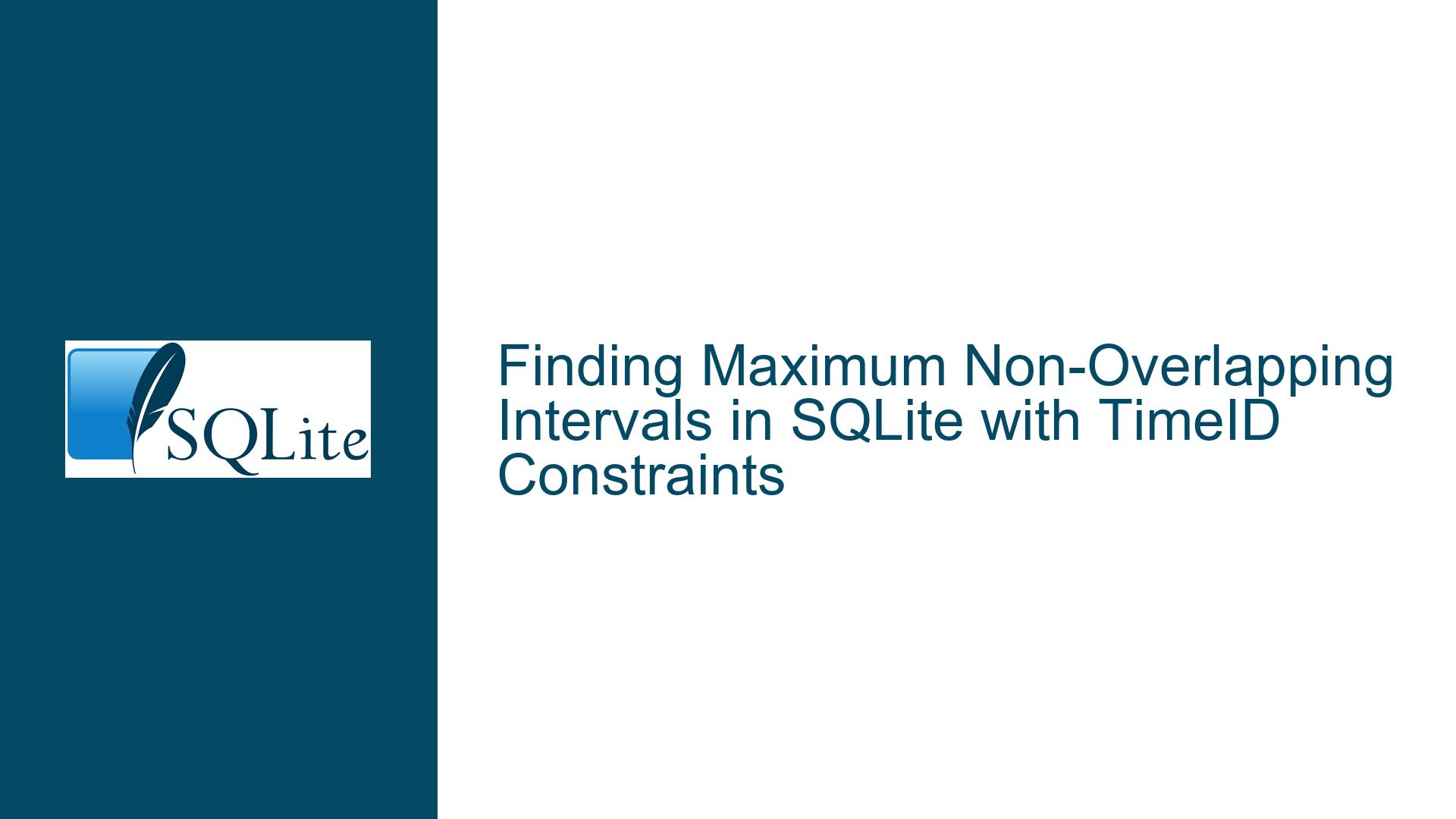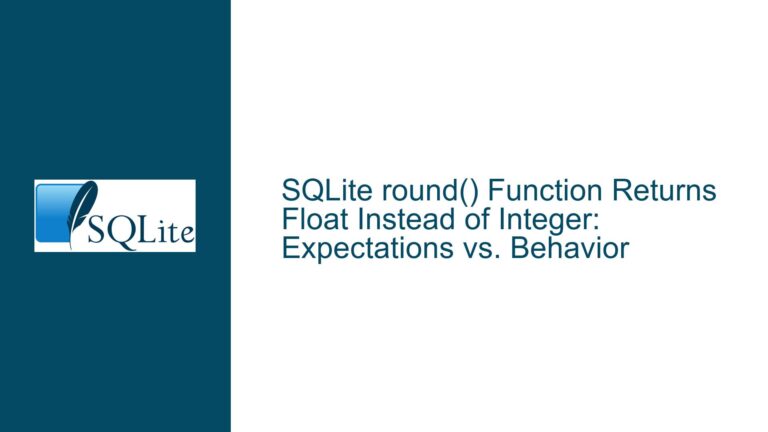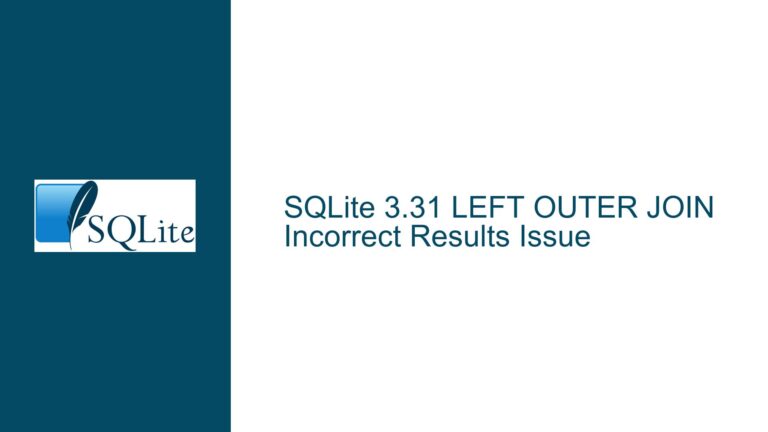Finding Maximum Non-Overlapping Intervals in SQLite with TimeID Constraints
Understanding the Problem: Non-Overlapping Intervals with TimeID Constraints
The core issue revolves around identifying a set of non-overlapping intervals from a database table where each interval is associated with a unique TimeID. The intervals are defined by their Start and End values, and the goal is to select the maximum number of intervals such that no two intervals with the same TimeID overlap. Additionally, intervals with different TimeID values are considered non-overlapping even if their [Start, End] ranges overlap.
The problem can be broken down into two key conditions:
- Non-Overlapping Condition: The selected intervals must not overlap with any other interval that shares the same
TimeID. Overlapping is defined as one interval’s[Start, End]range intersecting with another interval’s range for the sameTimeID. - Maximal Set Condition: The selected set of intervals must be as large as possible. This means that no additional interval from the remaining rows can be added to the result without violating the non-overlapping condition.
The challenge lies in constructing an SQL query that satisfies both conditions, especially given SQLite’s limitations, such as the lack of support for recursive aggregate queries.
Exploring the Causes: Why This Problem is Tricky in SQLite
The difficulty in solving this problem stems from several factors:
Recursive Nature of the Problem: The task requires evaluating intervals recursively to ensure that no overlapping intervals are selected. SQLite’s recursive capabilities are limited, particularly when aggregates are involved within recursive CTEs (Common Table Expressions). This limitation makes it challenging to implement a straightforward recursive solution.
Maximal Set Requirement: Ensuring that the selected set of intervals is maximal adds complexity. It’s not enough to simply filter out overlapping intervals; the solution must also guarantee that no additional intervals can be added without causing overlaps. This requires a more sophisticated approach than basic filtering or joining.
TimeID Constraints: The requirement that intervals with different
TimeIDvalues are always non-overlapping adds another layer of complexity. While this simplifies the problem in some ways (e.g., intervals with differentTimeIDvalues can coexist regardless of their ranges), it also means that the solution must handleTimeIDas a grouping factor, further complicating the query logic.Unknown Number of Overlapping Intervals: The number of overlapping intervals is not fixed, and the solution must be robust enough to handle any number of overlaps. This unpredictability makes it difficult to rely on static queries or assumptions about the data.
SQLite’s Lack of Advanced Analytical Functions: Unlike some other databases, SQLite does not support advanced analytical functions like
ROW_NUMBER(),RANK(), orLEAD()/LAG()out of the box. These functions could simplify the problem by allowing easier identification of overlapping intervals and their relationships.
Step-by-Step Troubleshooting, Solutions, and Fixes
Step 1: Defining the Problem Clearly
Before attempting to solve the problem, it’s crucial to define it precisely. The goal is to select a set of intervals such that:
- No two intervals with the same
TimeIDoverlap. - The selected set is maximal, meaning no additional interval can be added without causing an overlap.
This definition ensures that the solution is both correct and efficient.
Step 2: Understanding the Data Structure
The table structure is as follows:
CREATE TABLE test (
timeid INTEGER,
start INTEGER,
end INTEGER
);
Sample data:
INSERT INTO test VALUES(1, 0, 10);
INSERT INTO test VALUES(1, 2, 13);
INSERT INTO test VALUES(1, 11, 21);
INSERT INTO test VALUES(1, 15, 30);
INSERT INTO test VALUES(2, 0, 10);
INSERT INTO test VALUES(2, 2, 13);
INSERT INTO test VALUES(2, 11, 21);
INSERT INTO test VALUES(2, 15, 30);
The intervals are grouped by TimeID, and the goal is to select non-overlapping intervals within each group.
Step 3: Identifying Overlapping Intervals
To find non-overlapping intervals, we first need to identify overlapping ones. Two intervals [Start1, End1] and [Start2, End2] overlap if:
Start1 < End2ANDStart2 < End1.
This condition must be checked for intervals with the same TimeID.
Step 4: Attempting a Basic Filtering Approach
A naive approach might involve filtering out intervals that overlap with any other interval. For example:
SELECT * FROM test t1
WHERE NOT EXISTS (
SELECT 1 FROM test t2
WHERE t1.timeid = t2.timeid
AND t2.start < t1.end
AND t2.end > t1.start
);
However, this approach fails to produce a maximal set. It may exclude intervals that could be part of a valid non-overlapping set.
Step 5: Leveraging Recursive CTEs
Since the problem requires evaluating intervals recursively, a recursive CTE is a natural choice. However, SQLite does not support recursive aggregate queries, which complicates matters. The following attempt fails:
WITH RECURSIVE nol(id, start, end) AS (
SELECT test.timeid, test.start, test.end
FROM test
INNER JOIN (
SELECT timeid AS ttid, MIN(start) AS ttstart
FROM test
GROUP BY timeid
) AS tt ON tt.ttid = test.timeid AND tt.ttstart = test.start
UNION ALL
SELECT test.timeid, test.start, test.end
FROM test
INNER JOIN nol ON test.timeid = nol.id AND test.start > nol.end
GROUP BY test.timeid
HAVING MIN(test.start)
)
SELECT * FROM nol;
This query fails because SQLite does not support recursive aggregate queries.
Step 6: Moving Aggregates Outside Recursion
To work around SQLite’s limitations, we can move the aggregate logic outside the recursion. The following solution, provided by Bo Lindbergh, achieves this:
WITH RECURSIVE
forward (timeid, start, nextstart, nextend) AS (
SELECT test.timeid, test.start, MIN(next.start) AS nextstart, next.end
FROM test
INNER JOIN test next ON next.timeid = test.timeid
AND next.start >= test.end
GROUP BY test.timeid, test.start
HAVING nextstart IS NOT NULL
),
no_overlap (timeid, start, end) AS (
SELECT timeid, MIN(start), end
FROM test
GROUP BY timeid
UNION ALL
SELECT forward.timeid, forward.nextstart, forward.nextend
FROM no_overlap
INNER JOIN forward ON forward.timeid = no_overlap.timeid
AND forward.start = no_overlap.start
)
SELECT * FROM no_overlap;
This query works as follows:
- The
forwardCTE identifies the next non-overlapping interval for each interval by finding the minimumstartvalue that is greater than or equal to the current interval’send. - The
no_overlapCTE recursively builds the set of non-overlapping intervals by starting with the earliest interval for eachTimeIDand then adding the next non-overlapping interval identified by theforwardCTE. - The final
SELECTstatement retrieves the result.
Step 7: Validating the Solution
The solution produces the following output for the sample data:
timeid | start | end
-------|-------|----
1 | 0 | 10
1 | 11 | 21
2 | 0 | 10
2 | 11 | 21
This output satisfies both conditions:
- No two intervals with the same
TimeIDoverlap. - The set is maximal, as no additional intervals can be added without causing an overlap.
Step 8: Handling Edge Cases
To ensure the solution is robust, it’s important to test edge cases, such as:
- Intervals that share a boundary (e.g.,
[0, 10]and[10, 20]). - Intervals with the same
startandendvalues. - Large datasets with many overlapping intervals.
The provided solution handles these cases correctly by using strict inequality checks (next.start >= test.end) and ensuring that the selected intervals are non-overlapping.
Step 9: Optimizing for Performance
For large datasets, performance may become an issue. To optimize:
- Index the
timeid,start, andendcolumns to speed up joins and comparisons. - Consider breaking the problem into smaller chunks (e.g., processing one
TimeIDat a time) if the dataset is extremely large.
Step 10: Alternative Approaches
While the recursive CTE solution works well, alternative approaches include:
- Using application code to process the intervals iteratively.
- Preprocessing the data to mark overlapping intervals and then selecting non-overlapping ones.
However, these approaches may not be as efficient or elegant as the SQL-based solution.
Conclusion
The problem of finding maximum non-overlapping intervals with TimeID constraints in SQLite is complex due to the recursive nature of the task and SQLite’s limitations. However, by leveraging recursive CTEs and moving aggregate logic outside the recursion, a robust solution can be achieved. The provided solution satisfies both the non-overlapping and maximal set conditions, making it a reliable choice for this problem.






